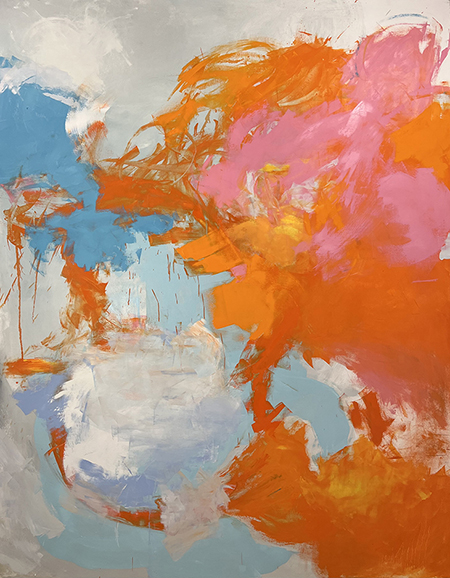
Continuing through October 9, 2023
Darren Orange has maintained a long inquiry into the landscape of the region that nurtured him, the Pacific Northwest. (The show's title refers to an imaginary world, which Orange likens to "creating your own universe.") Born and raised in Yakima, Washington, to third-generation apple orchardists, he earned a B.A. in painting with an art-history minor at Western Washington University. Since 2000 he has lived in Astoria, Oregon, except for a two-year stint in Santa Fe. Over that quarter century Orange has transliterated the Northwest’s rivers, mountains, forests, and logging towns into the genre of abstracted landscape.
Orange’s palette has tended toward earth tones, his gestures toward natural and human-made referents such as the cut of the horizon line across the Pacific Ocean or the span of the iconic Astoria-Megler Bridge, which connects Oregon and Washington. This stylistic and thematic consistency makes his new exhibition, “Paracosm,” all the more surprising a departure.
The 33 oil paintings that comprise “Paracosm” (all from 2022 and 2023) leave concrete referents behind in favor of pure abstraction. He also trades in his customary color palette of browns, blacks, and subdued gray-periwinkles for bright, bracing, edible sherbet hues. Nothing in Orange’s prior work prepared me for the pinks and juicy oranges of the show’s centerpiece work, the 7 by 5 1/2 foot “Synesthesia,” nor the lemon-yellows and bubblegum blues in “Proclivity to Shadow the Sun,” nor the scrumptious cherry reds of “Glass Skies.” His handling of paint, however, retains the flowing, self-assured brushwork viewers will recall from previous bodies of work. In fact, arguably Orange’s most successful paintings have been those in which bravura representational passages verged on abstraction.
His current deep dive into pure gesture seems to have liberated and invigorated him. There is a newfound ferocity, a jittery kineticism in his dashes and daubs with brush, palette knife, and spatula. A powerful centrifugal force animates “Thorn of the Recalcitrant” and “Abstracta Botanica,” their crescent-shaped gestures telegraphing mass and motion hurtling outward.
He comes to abstraction not on a pointless mission to change art, but to discover himself personally and aesthetically. The works on aluminum panel, in particular, lend themselves to what Orange calls “a wild ride in slippery, wet viscosity that makes the painting action fast and loose.” The surfaces are thick with impasto, perhaps a nod to the mutant textures of Anselm Kiefer, one of his big influences.
I place Orange’s style in the company of four Northwest painters of roughly his generation: Timothy Scott Dalbow, Jason Dickason, my late partner Dorothy Goode, and Scott Wayne Indiana in his work circa 2004-2007 — assertive, intuitive, and very much in the lineage of Abstract Expressionism. Lucinda Parker and Barbara Sternberger began working in this mode a generation earlier.
Orange has reshuffled the bones of this approach into something appreciably fresher that — having ditched the woodsy hues and heavily varnished surfaces of his incipient years for a brasher, more exultant palette without varnish — evinces a hyperspace jump after two decades of a consistent aesthetic message. His abstractions look suave and commanding here, their nubby surfaces, bold gesturalism, and Pop Art palette exuding a heady confidence as they update the painter’s Northwest ethos with an agreeable jolt of flash and verve.
Although this is Orange’s fourth solo exhibition at Imogen, it’s his first in the gallery’s expanded exhibition space, which doubled in size with a remodel in late 2021/early 2022. Some background about this gallery’s location far from an urban center; it is unique in Astoria. Imogen is a light-filled white cube, warmed by rustic wooden beams holding up the ceiling. It is well suited for the large-scale paintings that Orange favors, and for sculptures such as those of M.J. Anderson, whose show preceded Orange’s. It’s hard to overestimate Imogen’s impact on the Oregon Coast art ecosystem over the past decade.
Director/founder Teri Sund opened up shop in August 2012, incorporating coast-based artists such as Anderson and Marc Boone, as well as Portlanders like Corey Arnold, Tom Cramer, and Matthew Dennison, Lauren Mantecón from Santa Fe, and Anne Grgich from Seattle. Sund has an eye for work that is regional but not regionalist. This is not the place to buy a sunset-and-sand print to cart home as a souvenir of your vacation on Cannon Beach, and while the gallery does have a section for ceramics, glass, and jewelry, the doubling of the exhibition square footage keeps the ratio of contemporary art to craft at around 85/15, which is just about right for an integral but pragmatic seaside art space.
